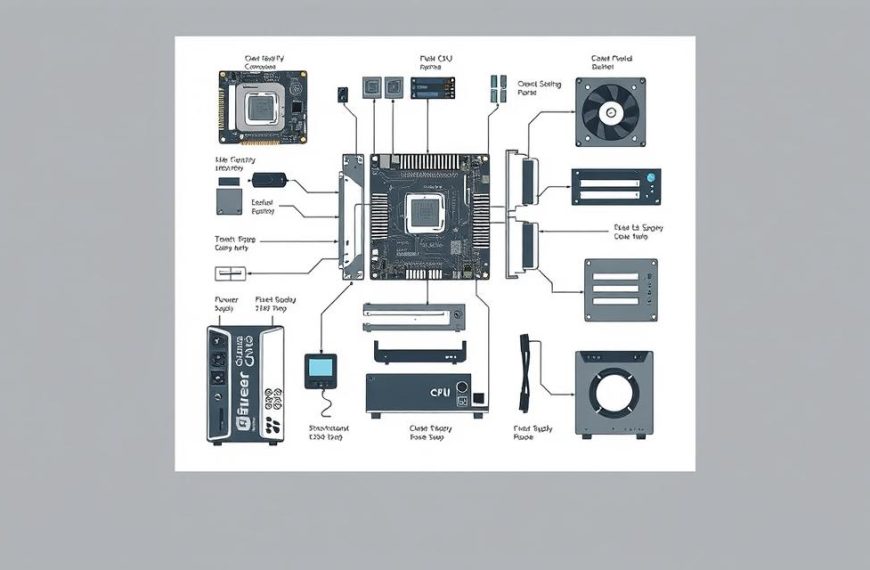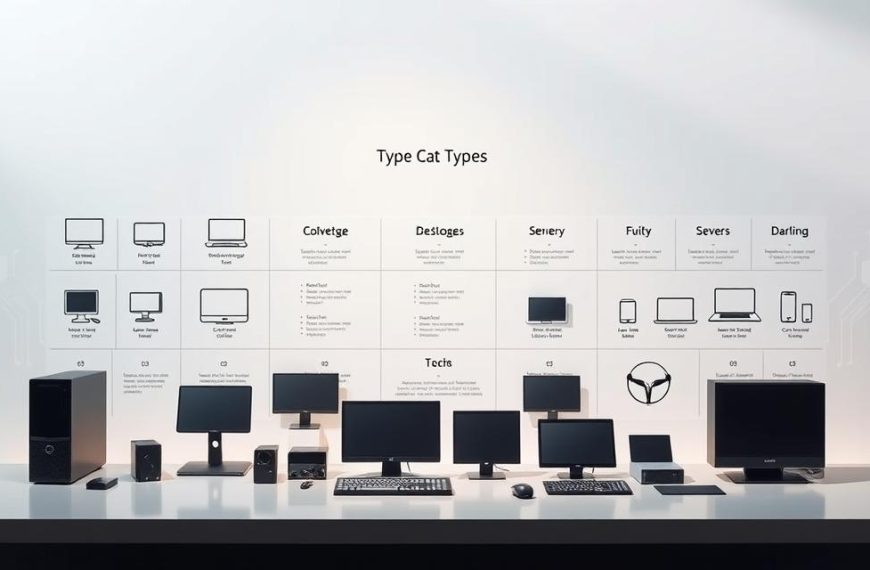Computer information systems (CIS) managers are key in today’s world. They mix technical skills with leadership to lead digital plans. They manage IT systems, make sure tech fits business goals, and oversee team work on security and efficiency.
In 2020, they earned a median salary of £151,150. The job is also expected to grow by 11%. This makes it a great choice for both money and job security.
One big job is strategic planning. CIS managers look at what the company needs and decide on new software or cloud services. They also handle budgets, risks, and talks with vendors to keep costs down.
They also need to lead and teach IT teams. This helps everyone work well together across different areas of the company.
If you’re thinking about a career in IT management, knowing what the job involves is key. It’s a role that needs you to be quick to adapt, with new tech like AI and cybersecurity coming up. CIS managers help link tech teams with top bosses, making sure plans are clear and doable.
Understanding the CIS Manager Position
In today’s world, Computer Information Systems (CIS) Managers are key. They link technology with business success. They need to know tech well and have a big picture view.
Definition and Core Purpose
A CIS Manager works where tech meets business goals. They make sure tech helps the company grow and stay ahead. This is different from just managing IT.
Bridging Technical Expertise With Business Strategy
These experts turn tech talk into business plans. For instance, they might:
- Turn cybersecurity into ways to lower risks
- Match cloud plans with budget times
- Link software updates to better customer service
This way, tech helps achieve business goals, not just support them.
Oversight of Organisational Information Flows
Good information governance is key for CIS Managers. In healthcare, they keep patient data safe but also let doctors access it quickly. Banks count on them to speed up transactions without losing to fraud.
They do things like:
- Check if data storage follows rules
- Make info easier to find
- Plan for when disasters happen
By keeping an eye on both tech and business, CIS Managers help tech grow with the company.
Core Responsibilities of Computer Information Systems Managers
Computer Information Systems Managers lead key tech operations. They mix technical skills with strategic planning. This keeps the company ahead and safe.

Strategic IT Planning
Aligning technology with business objectives
CIS Managers turn company goals into tech plans. For instance, a retail chain might need:
- Cloud-based inventory systems
- AI-driven customer analytics tools
- Omnichannel sales platforms
Budget allocation for infrastructure upgrades
IT infrastructure budgeting is about balancing now and later. BLS data shows 42% of IT leaders focus on cloud migration. Good managers:
- Do total cost-of-ownership analyses
- Negotiate with vendors
- Save 15-20% for unexpected costs
Systems Security Management
Implementing cybersecurity protocols
Ransomware attacks are up 35% each year (Source 1). CIS Managers use many defences:
- Endpoint detection systems
- Phishing tests for employees
- Constant network checks
Technology Implementation Oversight
Evaluating new software solutions
Software evaluation involves:
- 90-day trials
- Checking user experience
- Calculating ROI
Managing system integration projects
A manufacturing firm’s ERP shows success:
| Phase | Duration | Key Milestone |
|---|---|---|
| Planning | 8 weeks | Stakeholder alignment |
| Execution | 14 weeks | Data migration done |
| Optimisation | 6 weeks | Users on board |
Leadership in Technology Teams
Effective IT team leadership is about mixing technical skills with people skills. Managers need to create spaces where teams work well together. They must also keep their goals in line with the company’s aims.
IT Staff Management
Recruitment and Skills Development
CIS managers look for people who are good at tech and can adapt. They build teams with experts in cloud security and those who know old systems. They also have mentorship programs to help people get better:
- 90-day onboarding plans for new hires
- Cross-training in cybersecurity protocols
- Certification subsidies for emerging technologies
Performance Evaluation Frameworks
Teams are reviewed every quarter. They look at how well they do technically and how well they lead. The things they measure include:
| Category | Weighting | Measurement Tools |
|---|---|---|
| System uptime | 30% | Network monitoring software |
| Innovation initiatives | 25% | Project completion rates |
| Team collaboration | 20% | Peer feedback surveys |
Vendor and Stakeholder Relations
Contract Negotiations with Service Providers
Good vendor management leads to better service agreements. CIS leaders work on contracts that cover:
- Data sovereignty requirements
- Penalty structures for downtime
- Technology refresh cycles
Translating Technical Concepts for Executives
Managers need to explain IT stuff to top bosses. They turn network stats into how it affects work. They use:
- Visual dashboards showing ROI metrics
- Risk-adjusted investment proposals
- Three-year technology roadmaps
This focus on team growth and working with others helps companies deal with big digital changes.
Essential Technical Competencies
Today’s computer information systems managers need a mix of technical skills. They must design strong network frameworks and improve software delivery. All this must align with changing business goals.

Network Architecture Expertise
Creating strong digital infrastructures is key. Managers work on Azure infrastructure to meet growing data needs. They focus on:
- Hybrid cloud setups for security and access
- Monitoring network performance in real-time
- Following data governance rules
Cloud Computing Implementations
Moving to platforms like AWS or Azure needs careful planning. Many look for certifications like CompTIA Cloud+ to show they know how to manage multiple clouds.
Disaster Recovery Planning
Good managers plan for disasters. They create backup systems and test for cyber threats and hardware failures. This includes:
- Automated backups with geographic redundancy
- Simulating IT team responses to incidents
- Checking recovery time objectives regularly
Software Development Lifecycle Knowledge
Knowing DevOps practices is vital. It helps managers work well with tech teams. This knowledge helps bridge gaps between developers, QA, and operations.
Agile Methodology Applications
Modern projects use iterative development. Good implementation means:
- Planning sprints with available resources
- Daily meetings to solve issues quickly
- Improving processes through retrospectives
Quality Assurance Processes
Testing is key to avoiding expensive fixes later. Teams use automated tests and manual user reviews. Tools like Jira or Selenium are often used.
For those aiming for leadership, knowing these technical skills is important. It goes hand in hand with the strategic skills in our guide to information technology managers’ career paths.
Industry-Specific Applications
Computer information systems managers adjust their strategies for different sectors. They balance rules with new tech. Healthcare and finance are key areas, where data safety and rules guide IT plans.
Healthcare Sector Systems
Healthcare needs CIS managers to keep patient data safe while helping care. A data leak could harm patients or mess up treatments.
Patient Data Management Solutions
The NHS’s electronic health records show how to handle big data well. They have:
- Role-based access controls for staff
- Real-time updates for care teams
- Disaster recovery for emergencies
Compliance With Medical Regulations
Following HIPAA compliance means strong security. Healthcare focuses on keeping patient info private with:
- Encrypted chats
- Audit trails for access
- Strict checks on vendors
Financial Services Technology
Banks and fintech need systems to stop hackers and fraud. CIS managers must keep trust while speeding up digital payments.
Secure Transaction Processing Systems
Following PCI-DSS standards is key for payment safety. New tech includes:
- Blockchain for audits
- Tokenisation for card safety
- Tools for constant checks
Fraud Detection Mechanisms
Now, machine learning spots odd patterns. A UK bank cut phishing losses by 40% with:
- Behavioural biometrics
- Linking transactions across channels
- Quick account freezes
Challenges in Modern IT Management
Today’s IT world is fast-paced, yet it needs stability and reliability. Managers must find skilled workers and update old systems while keeping things running smoothly. Here are some ways to tackle these challenges.
Addressing Skills Shortages
The need for cloud security experts is growing, but there aren’t enough. This gap makes companies rethink how to keep their teams and invest in training.
Retaining Cloud Security Specialists
Just paying well isn’t enough to keep top talent. Successful companies offer:
- Flexible work options and clear career paths
- Freedom to work on projects with the latest tools
- Regular bonuses for skills and certifications

Apprenticeships cut costs and boost team spirit. Good examples include:
| Approach | Duration | Certification Rate |
|---|---|---|
| Cloud Security Bootcamps | 8-12 weeks | 78% |
| Vendor-Specific Training | 6 months | 91% |
| Cross-Department Mentoring | Ongoing | 65% |
For more on team growth, check out this analysis of IT manager problems.
Managing Technological Obsolescence
Many companies are stuck with old systems. Legacy modernisation needs careful planning to avoid problems.
Legacy System Migration Strategies
Phased updates work best:
- Map out all system dependencies
- Run new and old systems side by side for months
- Slowly replace old parts
Cost-Benefit Analysis of Upgrades
| Factor | Legacy System | Modernised System |
|---|---|---|
| Annual Maintenance | $187,000 | $63,000 |
| Security Incident Risk | High (62%) | Low (9%) |
| Staff Productivity | 73% Efficiency | 89% Efficiency |
“Migration costs pay off in 18 months by reducing downtime and security risks.”
Career Development Pathways
To move up in computer information systems management, you need to improve your skills and set clear goals. Those aiming for top jobs must work on both technical skills and soft skills. This dual approach helps in growing your career.

Certification Requirements
Certifications are key to advancing in fields like cybersecurity and cloud infrastructure. Over 42% of IT managers say getting certified helps them get promoted, as shown in CompTIA’s 2023 survey.
CISSP vs CISM Qualifications
| Certification | Focus Area | Ideal For | Average Salary (USD) |
|---|---|---|---|
| CISSP | Technical security architecture | Hands-on cybersecurity specialists | $125,000 |
| CISM | Risk management strategy | IT leaders overseeing security programmes | $138,000 |
Vendor-Specific Cloud Certifications
- AWS Certified Solutions Architect
- Microsoft Azure Administrator Associate
- Google Cloud Professional Cloud Architect
Programmes like WGU’s online degrees can help you get multiple certifications in 18-24 months. This can greatly shorten the time it takes to get promoted.
Progression to Executive Roles
To move from technical leadership to the C-suite, you need to master three areas. These are financial skills, working well with other departments, and speaking confidently in the boardroom.
Transitioning to CTO Positions
Most CTOs at Fortune 500 companies follow a similar path:
- 5-7 years in technical roles
- 3+ years managing big IT projects
- An MBA or leadership training
“Most CTOs now have both technical and business skills. 68% of new CTOs have MBAs, says Korn Ferry’s tech leadership study.”
Developing Board-Level Communication Skills
Good executive communication means:
- Turning technical data into business results
- Showing the value of IT spending
- Explaining risks in simple terms
Leadership courses at places like MIT Sloan teach “financial storytelling”. This is for IT pros aiming for executive roles.
Conclusion
Computer information systems managers play a key role at the crossroads of tech and strategy. They are vital in shaping the future of IT management. With 73% of companies focusing on AI, as Gartner’s 2023 report shows, they must keep up with new tools and models.
They face challenges like balancing security with fast tech adoption. They need to fill skills gaps with certifications like CISSP or AWS Certified Solutions Architect. They also need to get teams ready for blockchain in finance and IoT in healthcare.
Cisco’s 2024 Cybersecurity Report stresses the need for upskilling to fight new threats. IT leaders at JPMorgan Chase and Mayo Clinic show how cloud investments can boost business. They also highlight the importance of ethical AI and GDPR compliance.
Success in this field depends on ongoing learning and teamwork. Courses on quantum computing from Coursera and Udacity help managers prepare their teams. Joining forums like ISACA helps them stay ahead of tech risks.
As digital change speeds up, managers who understand these changes will lead the way in tech standards. Their choices today will shape how industries use new tech, from edge computing to AI. They will create strong, flexible business models.















